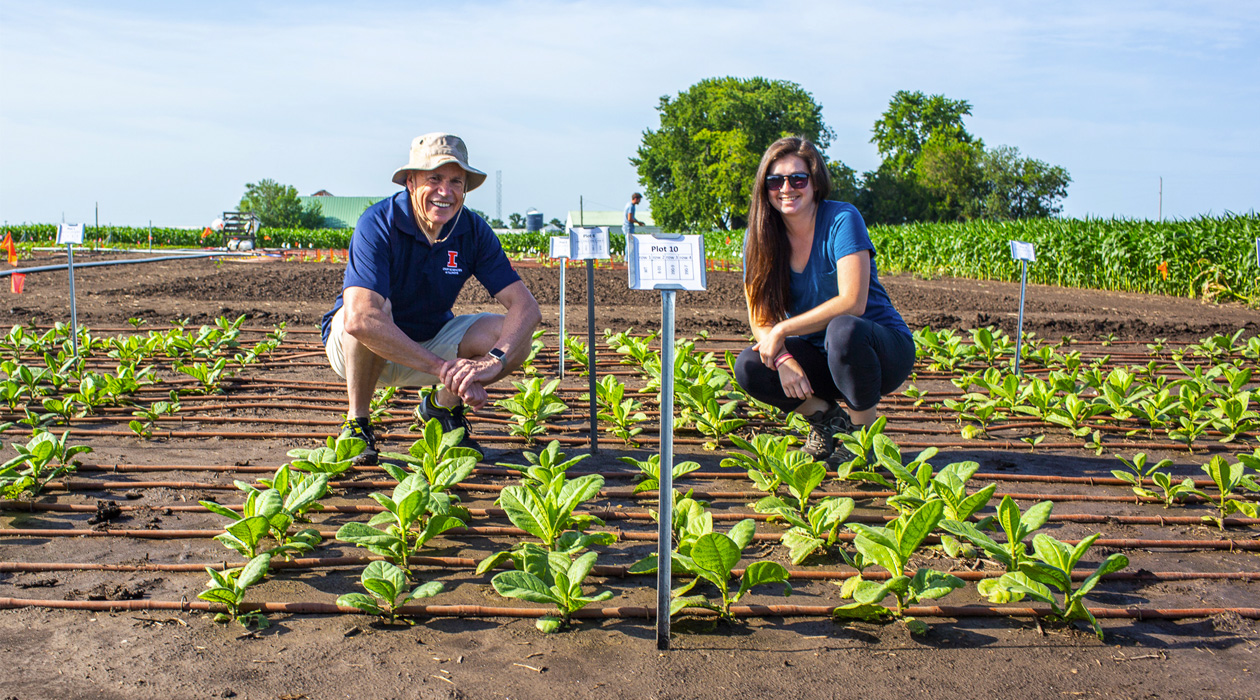Engineered increase in mesophyll conductance improves photosynthetic efficiency in field trial

Coralie Salesse-Smith (right) and Steve Long have proven in a model crop that an increase in mesophyll conductance can be engineered, and that it leads to an increase in photosynthesis.
It is possible to engineer increased mesophyll conductance in plants according to new research from the University of Illinois Urbana-Champaign. Mesophyll conductance plays a key role in photosynthesis and refers to the ease with which CO2 can diffuse through a leaf’s cells before reaching the location where it is ultimately turned into sugar to feed the plant (carbon fixation). CO2 faces barriers as it moves through the leaf, including its own cell walls. Researchers from the Long Lab at Illinois found that by increasing permeability and slightly reducing the thickness of cell walls, they could increase CO2 diffusion and uptake in a model crop.
“This is one of the few successful tests of concept showing that we can engineer an increase in mesophyll conductance and have it result in increased photosynthesis in the field,” said Coralie Salesse-Smith, a postdoctoral researcher in Long Lab (BSD/CABBI/GEGC) and lead author on a paper about the research, recently published in the Plant Biotechnology Journal. “Theory shows us that increasing mesophyll conductance to increase photosynthesis can be achieved without the cost of more water. This is important considering the urgent need for increased crop production and sustainable water use.”
Photosynthesis is the natural process all plants use to convert sunlight, water, and carbon dioxide into energy and yields. CO2’s journey to becoming useful sugar (energy) for the plant, begins when it passes through tiny holes in the leaves known as stomata. In order for the CO2 to reach the chloroplast, (where it is turned into sugar), it must travel through a number of barriers, including the cell wall. The team hypothesized that if they could improve CO2 diffusion across the cell wall by making these barriers easier to cross, it would improve mesophyll conductance and in turn photosynthetic efficiency. Increasing mesophyll conductance means that more CO2 will be available for the plant to turn into food. A previous paper by Salesse-Smith’s Realizing Increased Photosynthetic Efficiency (RIPE) colleagues showed that thinner cell walls are associated with higher mesophyll conductance. This suggests that intentionally decreasing the thickness of the walls could change how easily CO2 moves through leaves, potentially increasing photosynthesis. Inspired by this paper, Salesse-Smith wanted to test this idea in a model plant.
After a review of the literature, Salesse-Smith narrowed her focus to overexpressing, or increasing the amount of, CGR3, a gene that has been shown to alter cell wall components. This gene was inserted into a tobacco species and grown alongside plants without the gene in a field trial during the 2022 growing season. Tobacco was used as a model plant because it is easier to work with in laboratory and field settings, and also because it allowed the researchers to test the genetics at a quicker pace than with a food crop.
“Targeting the cell wall was very important because it is one of the main components limiting mesophyll conductance. Decreasing its thickness and making it more permeable would make it easier for CO2 to get to the site of carbon fixation,” said Salesse-Smith. “By over-expressing the targeted gene, we were able to decrease cell wall thickness and increase its permeability which, as we hypothesized, did end up increasing mesophyll conductance and, in turn, photosynthesis.”
RIPE, which is led by Illinois, is engineering crops to be more productive by improving photosynthesis, the natural process all plants use to convert sunlight into energy with supporters that include the Bill & Melinda Gates Foundation, Foundation for Food & Agriculture Research, U.K. Foreign, Commonwealth & Development Office.
The plants overexpressing the CGR3 gene showed a decrease in cell wall thickness of 7-13% and an increase in porosity of 75% when compared to the plants without this added gene. The team achieved their goal of making changes to the cell wall, but the true measure of success was when the data also showed an 8% increase in photosynthesis in the field.
“We hoped this modification would allow for more CO2 to get into the chloroplast and be used to create energy in the form of sugar, and that is what happened. But, just because it worked in a model crop doesn’t mean you get the same results with a food crop,” said Salesse-Smith. “It is important to test what happens in soybean to see if the same improvements in mesophyll conductance and photosynthesis will be achieved and if that leads to improvements in yield.”
Armed with these results, the team is working to test this modification in soybean, to see if increased photosynthesis, water use efficiency, and yield can be obtained in a food crop. Soybean field trials could take place as early as the 2025 growing season.
---
RIPE is led by the University of Illinois in partnership with the Commonwealth Scientific and Industrial Research Organisation, Lancaster University, University of California, Berkeley, University of Cambridge, University of Essex, and the U.S. Department of Agriculture, Agricultural Research Service.
The paper “Greater mesophyll conductance and leaf photosynthesis in the field through modified cell wall porosity and thickness via AtCGR3 expression in tobacco” published by the Plant Biotechnology Journal is available online.

